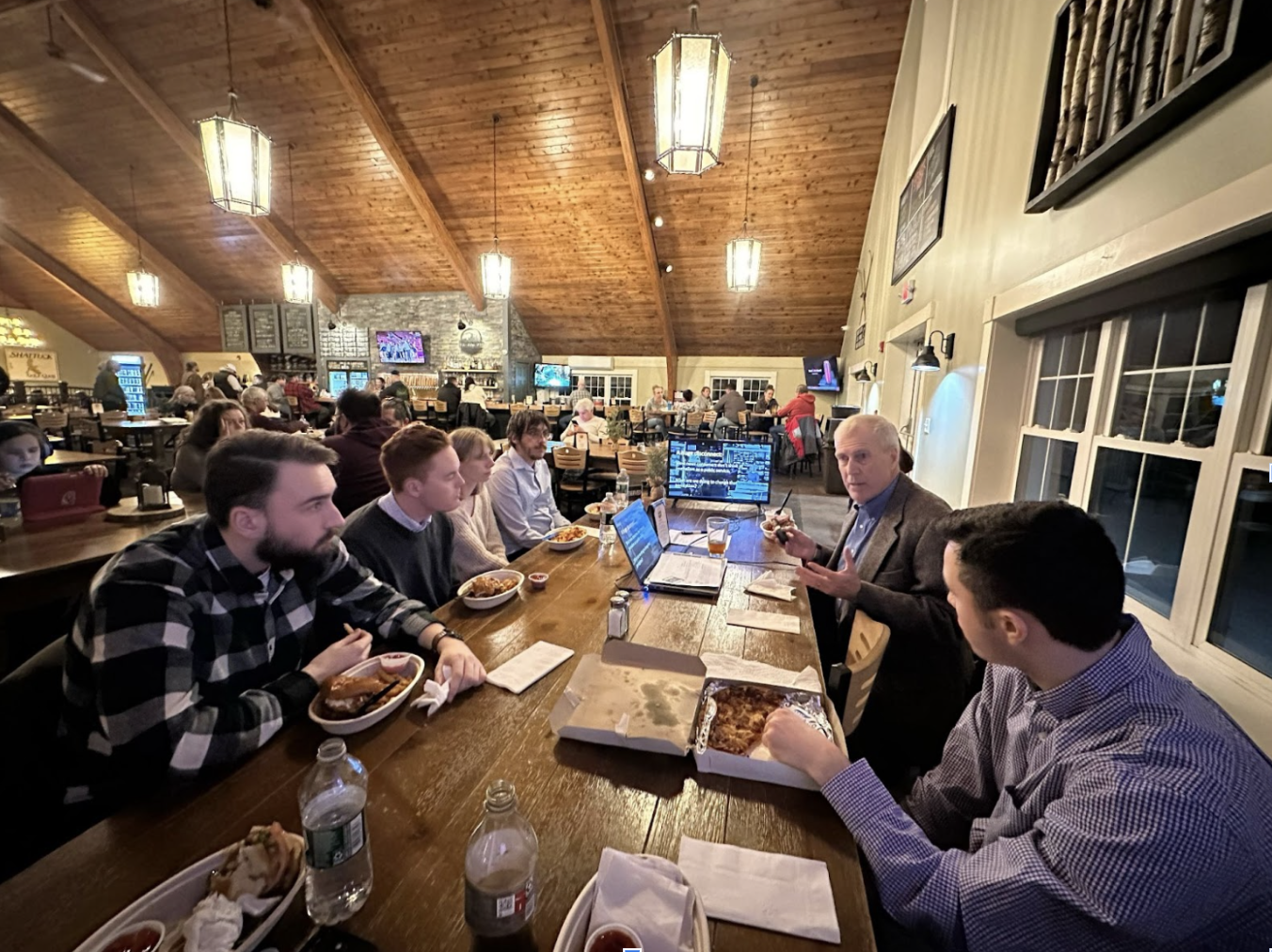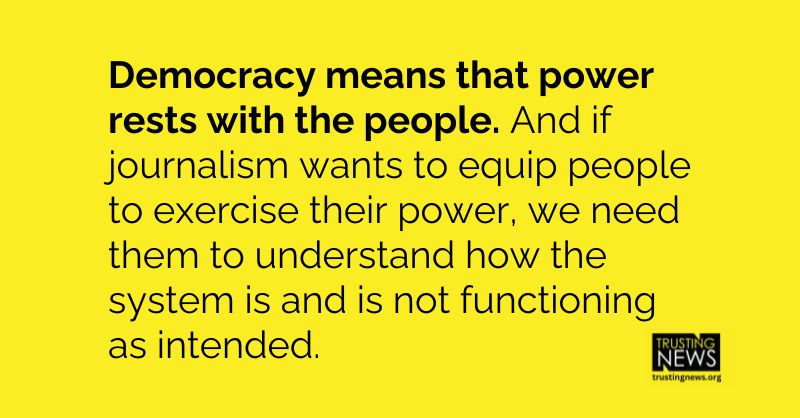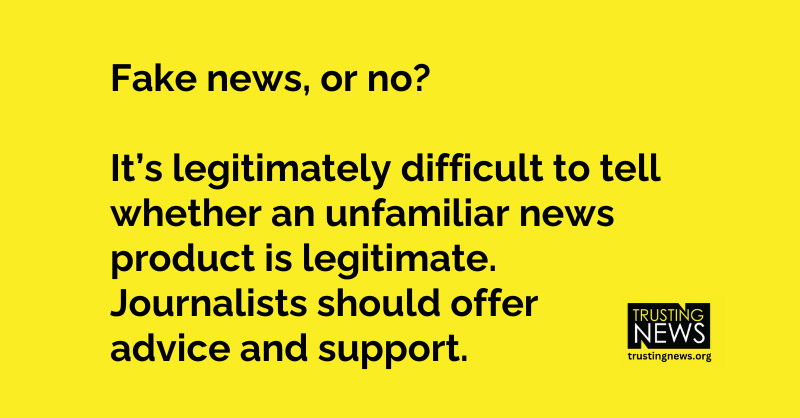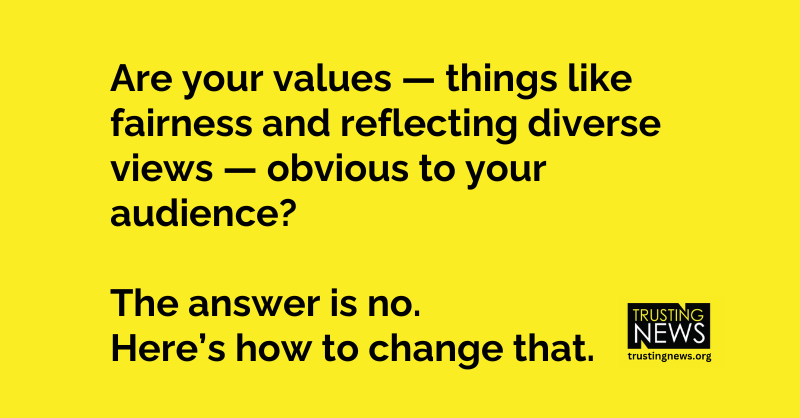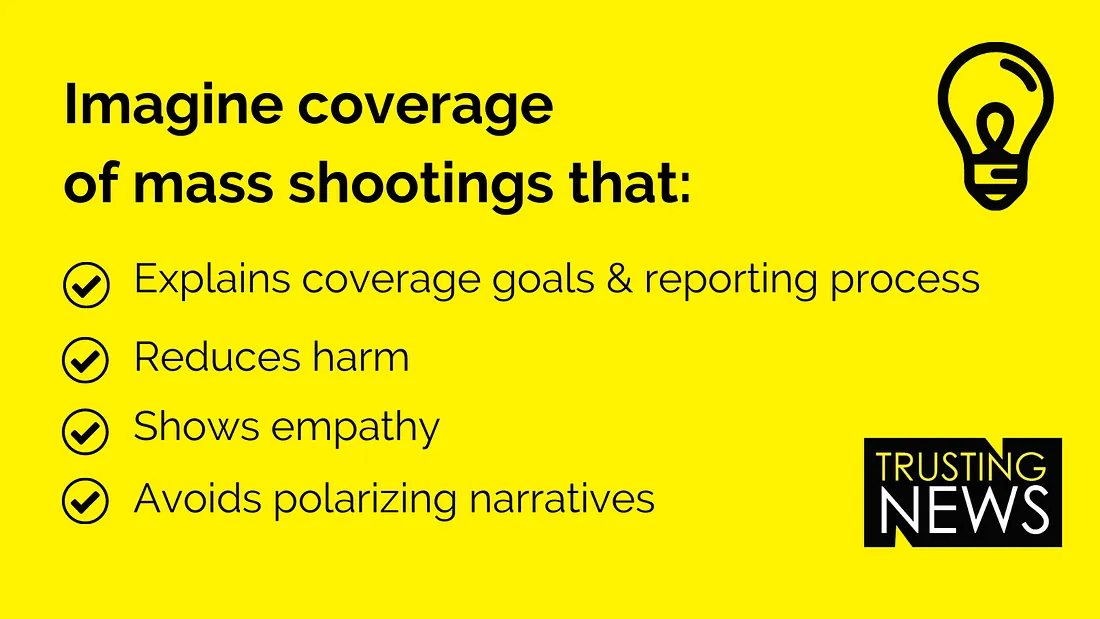
The news is tragic, and it’s unfolding in an all-too-familiar way. Innocent people have died. Society tries to make sense of the shooter’s motivation and mindset. People and organizations express outrage and sympathy. Paths forward are offered as if they’re simple solutions. Actual change and progress feel incremental or nonexistent. And journalists try to document […]
Explain your goals, process and integrity when covering mass shootings
The news is tragic, and it’s unfolding in an all-too-familiar way. Innocent people have died. Society tries to make sense of the shooter’s motivation and mindset. People and organizations express outrage and sympathy. Paths forward are offered as if they’re simple solutions. Actual change and progress feel incremental or nonexistent.
And journalists try to document and make sense of it all on behalf of their communities — all while trying to leave room to process it as human beings.
Our focus at Trusting News is on supporting journalists as they work to explain their coverage to their audiences. How can they make their mission clear? How can they acknowledge the failings of the media in general while defending their own work? What do they wish their community knew about their integrity?
Remember, every decision you make or ethical framework you rely on is invisible to your audience unless you draw their attention to it.
Here are some resources from our team that might be useful as you cover mass shootings.
If you put these ideas into action, please let us know, by email at info@TrustingNews.org or at @TrustingNews on Twitter. Every example we can collect makes it easier for other newsrooms to follow your lead.
- Have empathy for what it’s like to consume the news at times like this. It’s overwhelming and confusing. Consider helping your audience navigate it. Give them permission to turn it off. Point them to sources you trust. Here are a couple of examples of what that can look like. And here are tips to share with communities about how to tell if a specific report is credible.
- If this is not a local story for you, remember that your audience will hold you accountable for any partner or wire coverage you offer them. That’s a reasonable thing to do. Be careful with wire headlines and framing. Consider explaining who you trust for national coverage and what your staff is doing as well.
- If this is a local story for your staff, explain how you’re deploying your team and what they’re working on. It demonstrates the depth and breadth of your commitment but also allows for you to be honest about any limitations and your priorities.
- Explain how breaking news works. Remind people information will change and you will be cautious about what to share. Explain your verification process.
- If you’re getting accused of sensationalizing, not being careful with facts, etc., consider what you wish your audience knew about your integrity or your process. Turn those accusations into opportunities to explain yourself. And acknowledge that some coverage is irresponsible, inaccurate or sensational.
- If you cover any conspiracy theories related to the shooting, here are tips for taking care with that. (Remember, there are folks who will claim this event was a “false flag,” and that might warrant coverage.)
- Be careful not to play into lazy, polarizing narratives. Many people have complicated reactions to situations like this. Most people are not 100 percent sure that they know how to solve the problems or that it’s 100 percent the other guys’ fault. Look for complication, and keep asking questions until you get past the obvious answers.
- Explain what your goals are with coverage. Especially on hot button issues, think about what you wish people knew. Are you trying to help people understand an issue more fully? Are you trying to move beyond easy talking points? Are you trying to hold local officials accountable for solutions? Consider adding an editor’s note explaining that.
- If you take care with specific language or word choices, explain that. Also explain other choices you take care with. One potential example: giving more attention to the victims than the shooter.
- Take responsibility for the conversations you host. Moderate comments. Answer questions. And tell your audience you won’t tolerate misinformation.
- If you run opinion content connected to the shooting or related policies, please please please make sure that on every platform, it’s obvious that it’s opinion. Here’s our guide.
- If you publish something inaccurate — regardless of how or why it happened — correct the error publicly. Here’s our guide.
- Take care with your colleagues. You cannot thoughtfully work to earn the trust of your community if you do not also work to earn the trust of your staff. A request of a colleague to be fully present with a grieving community should not be treated casually. And it should be accompanied by resources to help them process the potentially traumatic experience. The Dart Center and the International Women’s Media Foundation are a good place to start, as is this piece about care as a core tenet of journalism. (This paragraph was written for a piece about covering police violence and added to this one after publication.)
And here are a few other resources:
- Be careful with coverage of guns. Journalists often use terminology incorrectly, which affects their credibility with people who already might be less likely to trust the news. This is a tip sheet for journalists covering firearms. And this is a website from Al Tompkins at Poynter with a bunch of resources.
- The Dart Center just put together these resources for journalists covering the Buffalo shooting. And here are all their resources related to self-care for journalists.
- Poynter also offers advice on how to take care of yourself while covering mass shootings and offers ways to work through it.
- Here are RTDNA’s resources (on ethics, personal safety, etc.) for journalists covering mass shootings.
- Consider the framework of trauma-informed reporting, especially if you’re talking to people who have been touched by the violence. (And if you take care with those interactions, explain that to your audience as well.)
What would you add? And what else could you use help with? Let us know, by email at info@TrustingNews.org or at @TrustingNews on Twitter.
At Trusting News, we learn how people decide what news to trust and turn that knowledge into actionable strategies for journalists. We train and empower journalists to take responsibility for demonstrating credibility and actively earning trust through transparency and engagement. Subscribe to our Trust Tips newsletter. Follow us on Twitter and LinkedIn. Read more about our work at TrustingNews.org.

Executive Director Joy Mayer (she/her) founded Trusting News in 2016 after a 20-year career in newsrooms and teaching. She lives in Sarasota, Florida, and can be reached at joy@TrustingNews.org.
